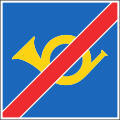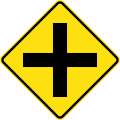| This article needs additional citations for verification. Please help improve this article by adding citations to reliable sources. Unsourced material may be challenged and removed. Find sources: "Priority signs" – news · newspapers · books · scholar · JSTOR (December 2009) (Learn how and when to remove this message) |
Priority traffic signs indicate the order in which vehicles shall pass intersection points. Vehicles often come into conflict with other vehicles and pedestrians because their intended courses of travel intersect, and thus interfere with each other's routes. The general principle that establishes who has the right to go first is called "right of way" or "priority". It establishes who has the right to use the conflicting part of the road and who has to wait until the other does so. The vehicle that does not need to wait is said to "have the right of way" or to "have priority."
Types of sign




A Give way sign, also known as a yield sign in some countries, informs the driver that they must give way to vehicles on the major road. Under the Vienna Convention, the standard sign shall be a white or yellow inverted triangle with a red border. This originates in Denmark, with the red and white coming from the Danish flag. In some countries, the words Give Way or equivalent may be included with the sign. These signs are usually accompanied by a give way marking, normally one or multiple dashed lines or shark teeth across the carriageway.
| Priority signs according to the Vienna Convention on Road Signs and Signals | ||||||
|---|---|---|---|---|---|---|
| Give Way | Inverted equilateral triangle | White or yellow | Red | 0.9 m (large), 0.6 m (small) | None | |
| Stop | Octagon | Red | White | 0.9 m (large), 0.6 m (small) | "STOP" written in white | |
| Circular | White or yellow | Red | 0.9 m (large), 0.6 m (small) | "STOP" written in black or dark blue inside red inverted triangle | ||
| Priority road | Diamond | White | Black | 0.5 m (large), 0.35 m (small) | Yellow or orange square | |
| End of priority road | Diamond | White | Black | 0.5 m (large), 0.35 m (small) | Yellow or orange square with black or grey diagonal lines crossing the sign | |
| Priority for oncoming traffic | Circular | White or yellow | Red | Unspecified | Black arrow indicating direction with priority, red arrow indicating direction without | |
| Priority over oncoming traffic | Rectangle | Blue | None | Unspecified | White arrow indicating direction with priority, red arrow indicating direction without | |
Alternative priority systems
-
 Sign indicating the route of priority road (thick line) at an intersection and defining the priority
Sign indicating the route of priority road (thick line) at an intersection and defining the priority
-
 Dangerous intersection with priority indication (for the next intersection only). Different variants of the sign can be used on both priority- and non-priority roads. Each sign has the thicker line indicating the road or direction that has priority with the viewer's own direction being from the bottom of the sign.
Dangerous intersection with priority indication (for the next intersection only). Different variants of the sign can be used on both priority- and non-priority roads. Each sign has the thicker line indicating the road or direction that has priority with the viewer's own direction being from the bottom of the sign.
-
 Swiss mountain postal road sign: priority given to public transport, such as postal bus (pay special attention to the specific three-tone-horn of the postal bus approaching hairpin bends and wait before the bend; traffic users must follow instructions given by public transport drivers)
Swiss mountain postal road sign: priority given to public transport, such as postal bus (pay special attention to the specific three-tone-horn of the postal bus approaching hairpin bends and wait before the bend; traffic users must follow instructions given by public transport drivers)
-
 Swiss end of mountain postal road
Swiss end of mountain postal road
-
 A Filter in turn in the Channel Islands, which indicates that traffic from different approaches has alternating priority at the junction.
A Filter in turn in the Channel Islands, which indicates that traffic from different approaches has alternating priority at the junction.
-
 Yield at roundabout sign, left-hand traffic version
Yield at roundabout sign, left-hand traffic version
-
 Yield at roundabout sign, right-hand traffic version
Yield at roundabout sign, right-hand traffic version
-
 Turn left, yield on green arrow
Turn left, yield on green arrow
-
 Turn right on red arrow
Turn right on red arrow
-
 Yield to trams
Yield to trams
-
 Stop for all directions, then they yield to left
Stop for all directions, then they yield to left
-
 Stop for all directions, then they yield to right
Stop for all directions, then they yield to right
-
 Side road on the left with priority (diamond)
Side road on the left with priority (diamond)
-
 Side road on the right with priority (diamond)
Side road on the right with priority (diamond)
-
 Side road on the left (diamond)
Side road on the left (diamond)
-
 Side road on the right (diamond)
Side road on the right (diamond)
-
 Side road on the left with priority with a thick line (diamond)
Side road on the left with priority with a thick line (diamond)
-
 Side road on the right with priority with a thick line (diamond)
Side road on the right with priority with a thick line (diamond)
-
 Crossroads under general priority (diamond)
Crossroads under general priority (diamond)
-
 Crossroads with priority (diamond)
Crossroads with priority (diamond)
-
 Crossroads with priority with a thick line (diamond)
Crossroads with priority with a thick line (diamond)
-
 Crossroads with a major road
Crossroads with a major road
-
 T-intersection with a major road
T-intersection with a major road
-
 T-intersection sign
T-intersection sign
-
 Crossroad priority sign on the left
Crossroad priority sign on the left
-
 Crossroad priority sign on the right
Crossroad priority sign on the right
-
 Y-intersection sign
Y-intersection sign
-
 Y-junction on the left
Y-junction on the left
-
 Y-junction on the right
Y-junction on the right
-
 Crossroads with priority (triangle)
Crossroads with priority (triangle)
-
 Side road on the left with priority (triangle)
Side road on the left with priority (triangle)
-
 Side road on the right with priority (triangle)
Side road on the right with priority (triangle)
-
 Bikes yield to pedestrians
Bikes yield to pedestrians
-
 Yield to pedestrians
Yield to pedestrians
-
 Yield to pedestrians
Yield to pedestrians
-
 Yield to cyclists (triangular shape)
Yield to cyclists (triangular shape)
See also
References
- "Road Traffic and Road Signs and Signals Agreements and Conventions | UNECE". unece.org. Retrieved 2021-09-12.
- Bekendtgørelse om Hovedfærdselsaarer, 27. marts 1937, Denmark
| Traffic signs | |||||||||||||||
|---|---|---|---|---|---|---|---|---|---|---|---|---|---|---|---|
| Signs |
| ||||||||||||||
| By country |
| ||||||||||||||
| Lights | |||||||||||||||
| Typefaces | |||||||||||||||
| International conventions |
| ||||||||||||||
| National standards | |||||||||||||||
| Comparisons | |||||||||||||||
This road-related article is a stub. You can help Misplaced Pages by expanding it. |